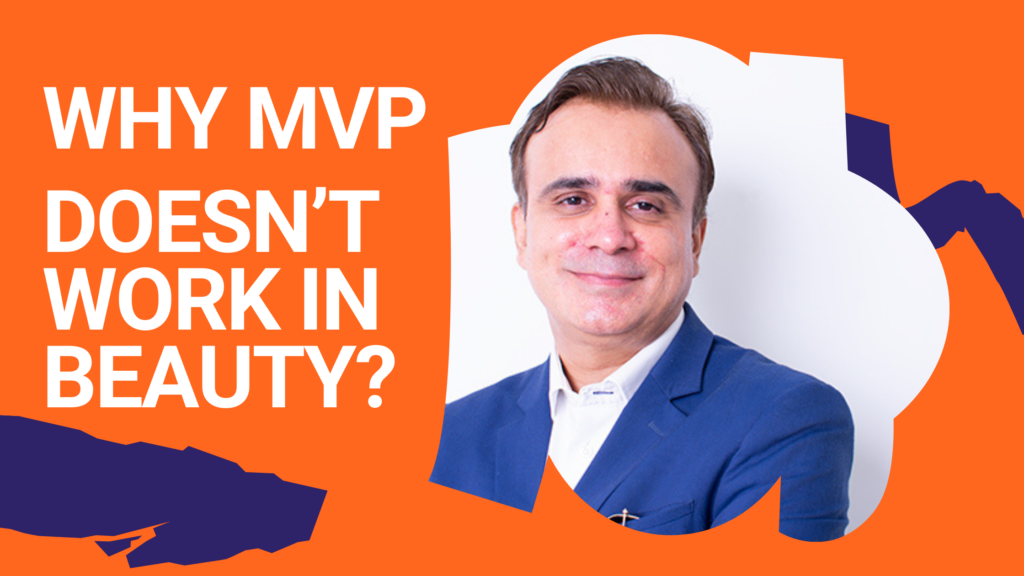Minimum viable product in beauty is likely a bad idea. MVP is an approach popularized by The Lean Startup Process.
MVP helps you validate your assumptions with minimal resource investment and could promise venture attractiveness for founders and investors.
However, it’s fraught with its shortcomings, esp. for beauty brands, that could lead to
1. False Starts
There is a lack of preliminary research to bring a solution that is never a fit for a problem that the consumer is willing to pay for. So, they never solved a problem that was a pain point for the target consumer.
False starts usually cause a more frequent need for pivots, each of which consumes time, money, and patience. When a founder runs out of these, it’s closing time.
-False starts can create an unprofessional perception as the early-stage stakeholders for beauty might see through your random jumps around
-Poor positioning that doesn’t resonate despite changes
-Touchpoint experience is neither relevant nor distinct
What causes false start?
-Bias for action
Beauty founders would instead research and develop products rather than interview consumers and get to the core problem.
Founders would instead jump fast to “TELL” the whole world, social followers, retailers, influencers, trade press, and lead consumers rather than “LISTEN” and slow down.
“Patience is not one of their virtues,” a modified quote from Wesley Snipes, Demolition Man.
-Introvert founders
Hate the idea of going and asking consumers
-Arrogant founders
Follow the Steve Jobs Fallacy, “The consumer doesn’t know.”
-Confirmation bias
Those who seek feedback or input pose leading questions and influence the response with questions like “Isn’t this a great solution?” or “How much do you like this idea?”
-YDKWYDK
You don’t know what you don’t know. Founders don’t know how to conduct consumer research and arrive at insights into consumers’ actual needs.
How to avoid false starts?
-Proper consumer research
Uncover core consumer problem
-Avoid convenience sampling
Researching friends and family
-Complete research
Both early adopters and mainstream consumers
-Deep dive
Uncover unmet needs/problems and not seek future behaviour
-Don’t pitch your solution
Focus on uncovering the problem or why someone buys your brand repeatedly
Example of a false Start by a beauty brand
Most indie beauty brands that don’t exceed $100K in annual revenues are simply victims of validation by friends, family, and local consumers who buy their products to support them and the local economy but don’t have a reason beyond that.
False Positives
False positives raise the founder’s confidence in the brand’s path to scaling up. The underlying assumption is that mainstream consumers will demonstrate the same behaviour as the early adopters, whether around consumption or the volume of consumers.
What boosts false positives?
-Need for Speed
The allure of fast-paced growth drives some founders, something they relish and thrive on.
-Investors’ Moon Shot
Investors, even angel investors, start dreaming of dreamy payoffs blinded by false positives and tend to overlook future growth challenges.
How to avoid false positives?
-Research
Both early adopters and mainstream consumers before launch to notice the difference in their current and projected consumption
-Post $100K
After your beauty brand has had some success, let’s say between $100K-$1M, researching and segmenting your loyal fans and not-so-loyal buyers and understanding key differences
-Founder’s self-awareness
A co-founder, advisor or investor could help cite the risks that could derail because of huge false positives.
-Vetting Investors
Less than 2% of women founders get funded, and women found the majority of indie beauty brands; since funding is so scarce, they are highly likely to take money in perpetual gratitude than by doing their due diligence on the investors. Ask to speak to other brands funded by the investors, even if you are off their radar, talk to the brand founders and seek information objectively about the investors.
Example of a false positive for a beauty brand
Jaleh Bisharat’s Naked Poppy closed despite its success with early adopters because mainstream consumers were not willing to pay a premium for a product they could buy slightly cheaper elsewhere, despite its clean focus and clean pioneer status.
Recently, Boscia skincare closed(Closing date: May 31, 2024) because of an unsustainable marketing funnel when it was time to acquire and retain the mainstream consumer, reflected in the statement by one of the CXOs at Boscia
What's the Ultimate Result of MVP-based Thinking?
-Flawed understanding of target consumer behaviour for funnel profitability
Ultimately, a venture’s success depends on its profitability. The time to profit can depend on your cash coffers, but if the venture is not profitable within a certain timeline, then it’s doomsday.
For a venture to be profitable, it needs a profitable funnel. An MVP approach, whether due to a false start or a false positive, will likely result in an unprofitable funnel, especially when you invest in growth without growth and loyalty validation for both early adopters and mainstream consumers.
SUMMARY
Minimum Viable Product is not likely to work in beauty for the following reasons.
It can lead to false starts since you won’t do exhaustive and thorough research to validate your assumptions and value proposition, only to find later that you still need to solve a real need, different or better than anyone else.
Another reason for flawed MVP thinking is the tendency to fall prey to false positives caused by differences between the needs and behaviours of early adopters and mainstream consumers.
The cure is thorough consumer research of both early adopters and mainstream consumers, vetting investors, and founder self-awareness.
Do check out my article on How innovative is your beauty brand?
Jump offers profitable growth to women-led, early-stage beauty brands with a “fit, fundamental & fully executable” solution using first principles of diffusion
OR

